- Published: Thursday, 30 May 2019
It was a whirlwind of a week in Malaysia at Shell Eco-marathon Asia. The air was constantly buzzing with intense excitement and anticipation, mixed with the tension of competitive anxiety.
So how did Girton go?
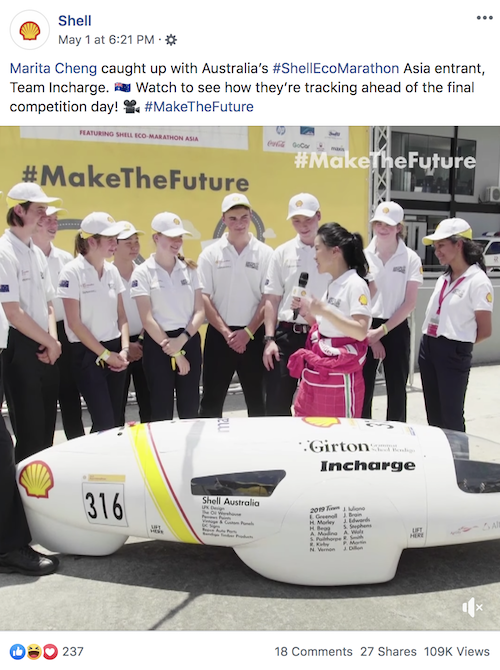 (click here or on the image above for a video summary of Day 3)
(click here or on the image above for a video summary of Day 3)
I also got to hop in and out of the Girton car to see if I could get out in below 10 seconds as per Tech Inspection rules - watch to see me fail to do that!
 (click here or on the image above for a video summary of Day 4)
(click here or on the image above for a video summary of Day 4)
Turns out the car had a glitch during its first run, leading it to stop within metres of the finish line!
Attempt 1 efficiency: NA. Driver: Emma.
All Incharge driver Emma had to do the next time a glitch happened was to press the reset button and the car would restart and make its way across the finish line. So the strategy for round 2 was to get a run on the table. It wasn’t perfect, with the motor playing up, meaning the car stopped and started. They were trialling a new strategy that ended up causing the Girton car to stop unintentionally on the second lap, a stressful experience, resulting in a manual restart when the system wasn’t quite right. Despite the glitches, the team managed to get a run on the board, a huge delight to the team! As Emma said afterwards, "Getting a valid run was one of the most relieving things!”
Attempt 2 efficiency: 229.9 km/kWh. (The higher the efficiency, the better.) Driver: Emma.

For the 3rd run, the team reverted to their previous strategy. The motor again played up, never stopping, but not quite doing what the code wanted.
Attempt 3 efficiency: 248.9 km/kWh. Driver: Jess.
The 4th run implemented the same strategy as the 3rd run, eliciting similar results and the same glitches. Again the car didn’t stop but again the motor didn’t perform as coded.
Attempt 4 efficiency: 243.3 km/kWh. Driver: Emma.
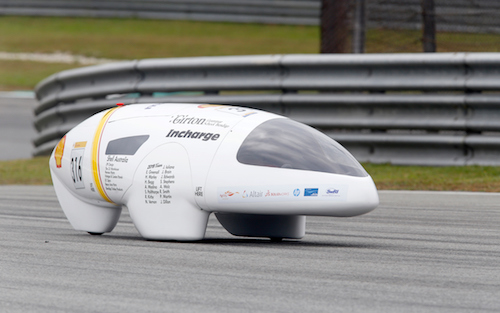
For the 5th run, the team decided to change up the drive system. This resulted in the car stalling on the Sepang Circuit’s hill. Having only completed half a lap before getting stuck, the vehicle had to be taken back to the pits.
Attempt 5 efficiency: NA. Driver: Jess.
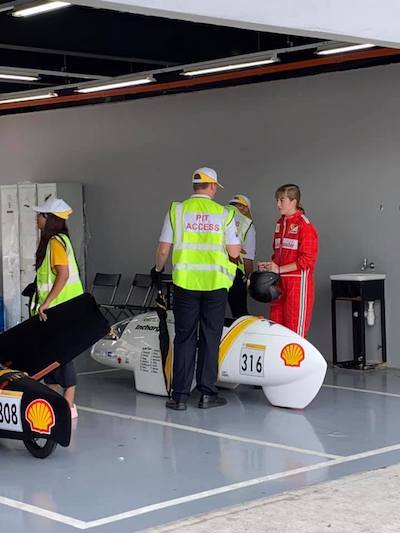
With only three laps to prove themselves, for the 6th run. the Girton team once again changed their code and strategy. This resulted in Girton driver Jess driving the first full, smooth run, and their best efficiency!
Attempt 6 efficiency: 284.4 km/kWh. Driver: Jess.
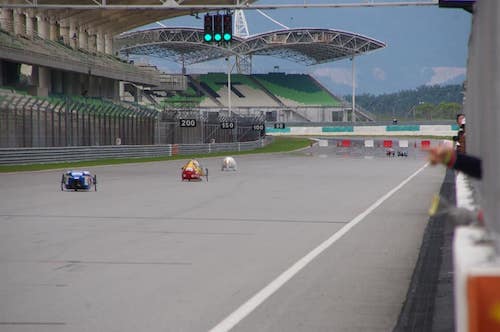
Having found the winning formula, it was decided that for the 7th run, the car and Emma would run on the same code and strategy. This run resulted in a similar time and efficiency to the previous run − proving to the judges the Girton drivers’ competency and the car’s consistency.
Attempt 7 efficiency: 282.8 km/kWh. Driver: Emma.
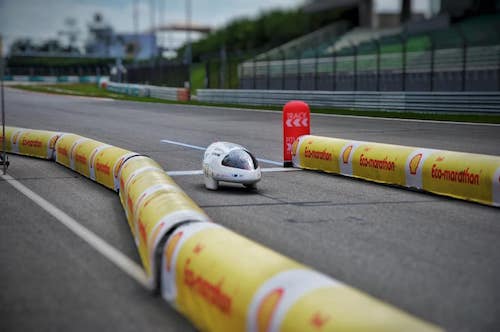
Each team is allowed eight runs around the track. With Girton racing to charge their battery and get back on the track after their 6th attempt, they were the second last car to get out on the track with their 7th attempt and ran out of time for a final attempt.
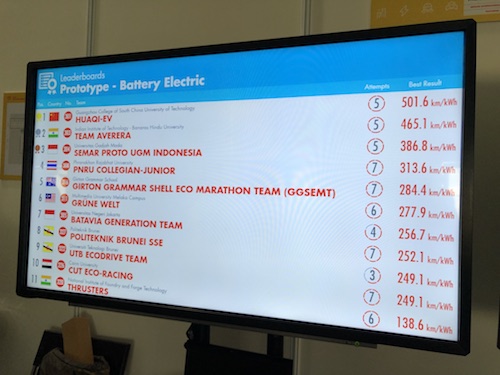
With all the racing done, and the results tallied, Team Incharge came in 5th place! Beating their 6th place finish from last year! The team was stoked and relieved that they improved and placed better than last year! And were pretty chuffed to achieve that result as a high school entrant!
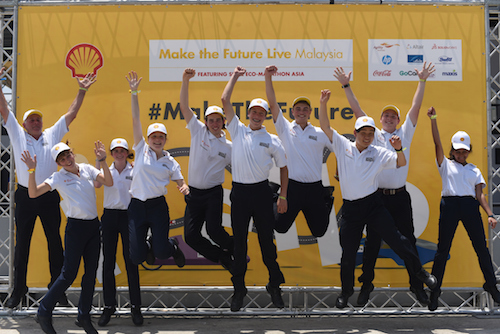
It was a great experience for the Girton team, with Incharge’s other driver Jess saying that “Other students should participate if they feel like they will find this sport interesting and intriguing.” For Jess, she enjoyed “building things and electrical components”, which was why she put her hand up when Mr Smith asked for students to volunteer their participation.
And regardless whether you want to be an engineer or not, the skills you learn from a competition like Shell Eco-marathon are transferable to any industry.
As Emma said, “I don’t suddenly want to be an engineer but I have a great respect for what they can do, it blows my mind how they can connect all these wires and things and have a moving vehicle! For me, this experience will forever be remembered and I have learnt many life skills and things about myself that I will use in the future.” Other team members added: “I learnt things about myself, like pushing myself a bit and staying calm in situations where it is tense.” “I learnt so much! A lot about myself and my friends and lots about F1 tracks.”
The team agrees though that the best part of the week was all about the people with the highlights being “meeting new people and driving on the formula track”, “working as a team and riding the highs and lows of the week with everyone”, and “working with and hanging out with my team was probably my favourite part of the whole week”.
And as for advice the team gives to future teams who may want to participate?
“Get prepared before even leaving for the event. Organisation is key. But once you’re there, just keep a smile on your face and it will spread to people around you.” “It was a really fun week where you can meet other teams.” “It’s an experience like no other.” “I was trying to be open with what I thought would happen as I really had no idea. It was crazy busy and stressful but so rewarding.”
And how was the whole thing?
Weather
I feel that weather played such a big role that it would be remiss not to mention it. The weather there was very trying. It was very hot and humid. When the sun was out, the concourse was clear. People preferred to shelter in the air-conditioned tents, called the “Paddock”, where each team had a small 12 x 12 space to assemble and troubleshoot their cars. When clouds gathered above and a slight breeze joined the air, people would emerge and collaborate outside.
The weather at Shell Eco-marathon will of course change depending on where it’s held, so it might not be as hot and humid next year, if it’s held somewhere else.
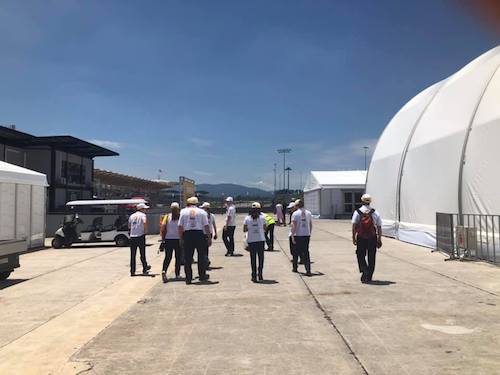 Girton team under the hot sun on the concourse
Girton team under the hot sun on the concourse
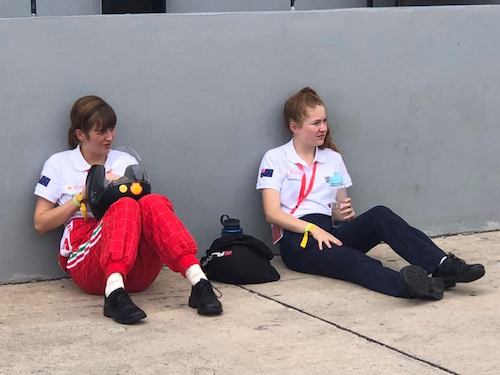
Girton drivers resting from the hot sun
Food
They made sure we were fed and watered. Our goodie bags contained a few bottles of Pepsi, a few packets of potato chips and various other snacks.
We also got a stash of meal coupons for lunch and dinner when we registered. And there were water coolers everywhere. There were meat and vegetarian options. It was packaged like plane food, which made it fun to eat.
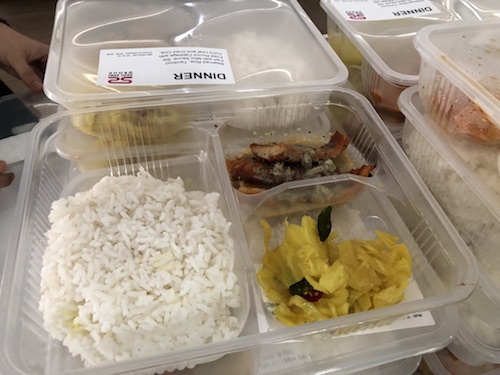 Dinner
Dinner

Shell Eco-Marathon Asia Mess Hall
Teams
Due to the intensity of the heat and exhaustion from the competition preparation, there were a lot of team members sleeping in their Paddocks throughout the week. I don’t blame them − it’s a full-on week! You’re working really hard to get your vehicle ready for competition. And then if you’re waiting for your turn before racing or an event, catching a few ‘zzz’s is a good use of time. The Girton team began the week chirpy and on adrenalin, but by the end of the week, were all falling asleep in their paddock as well! Teams also spent time on fixing and testing their cars, and going around to other teams to find out how their competitors’ cars were made.
 Girton team sleeping in their Paddock
Girton team sleeping in their Paddock
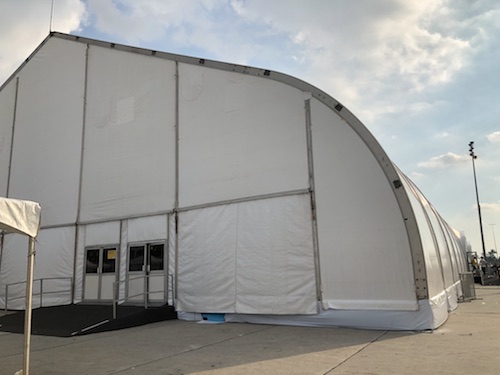
The giant tent that housed all the Paddocks
Gender
There were lots of men in the teams. It was wonderful to see the Girton team have four girls and five boys. There were also some entirely female teams as well, which was great to see!
Stats
About 20% of the teams at Shell Eco-marathon were high school students. Around 6-7% of the teams didn’t make it through tech inspections. And about the same percentage would struggle to get up the famous Sepang Circuit hill due to a lack of power in the vehicle.
Organisation
The whole event was very well organised − the organising team were a well-oiled machine. For example, you had to watch a safety video before being allowed to wander around the area. After watching the safety video, you were given a wristband that you had to show wherever you went. If you took the wristband off, you would have to watch the safety video again in order to get a new wristband! (So I had to keep my wristband on all the time from Monday - Thursday). Teams were given buzzers so they could be told when to take their vehicles to the various rooms for the opening ceremony and tech inspections. There was a first aid station in the middle of the Paddock. And copious amounts of a large variety of snacks − in particular Pepsi, chips and gum.
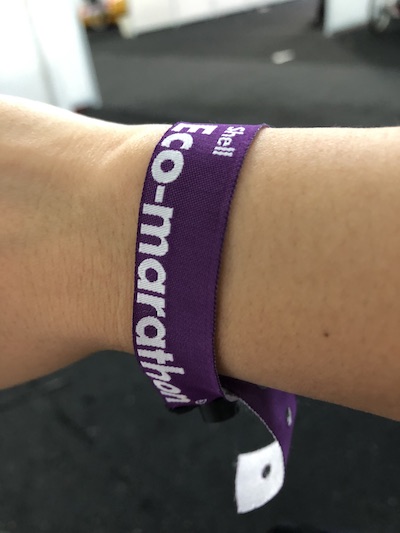 My wristband that I wore for 4 days
My wristband that I wore for 4 days
Overall
Overall, the entire week was very well done. It was very well organised and all the teams were looked after well. But most excitingly, the teams got to build vehicles and run them on a Formula circuit! How insane is that? Mind blown!
I had an amazing time at Shell Eco-marathon Asia. If you’re a teacher, or a university or high school student, I encourage you to find out more about the competition and participate!
If you have any questions about the competition or the experience, feel free to ask me! :)
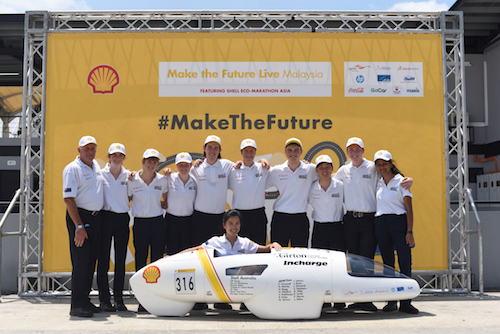

More photos of cars and teams around Shell Eco-marathon Asia:
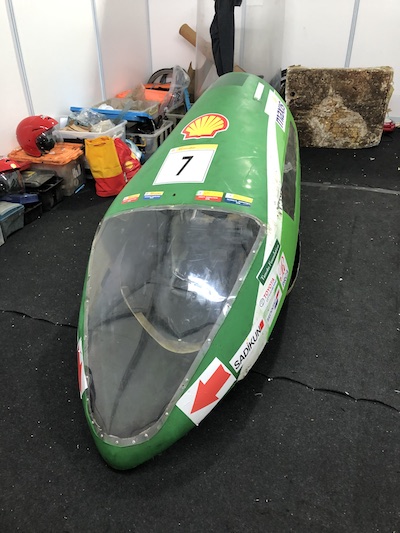
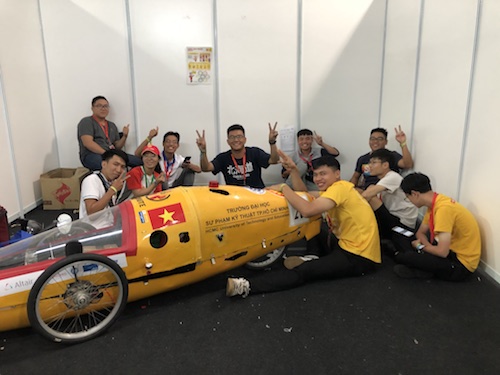
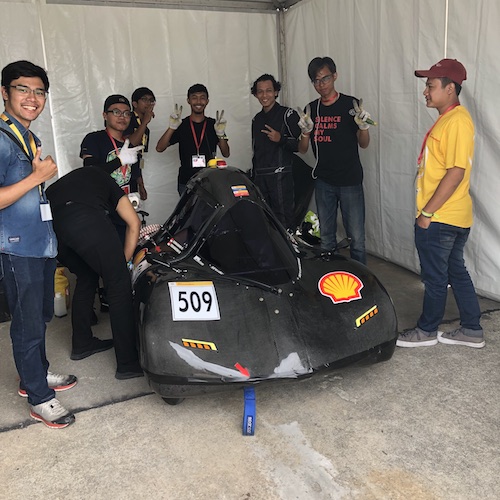
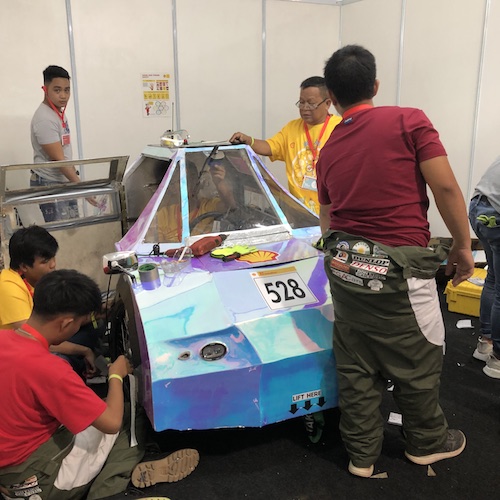
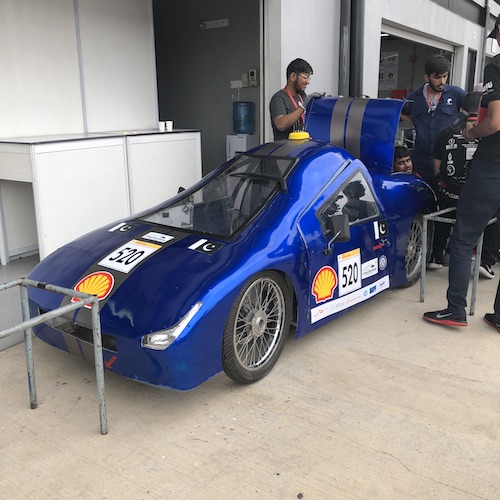
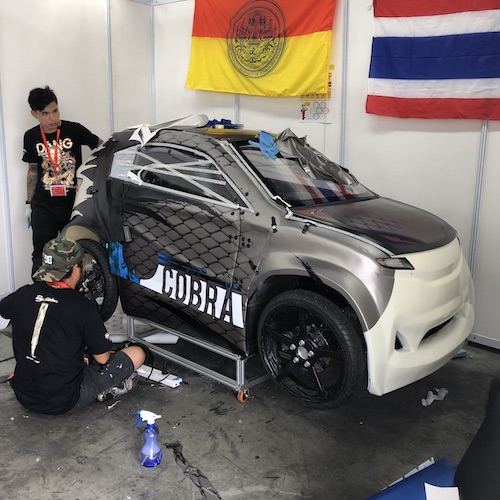
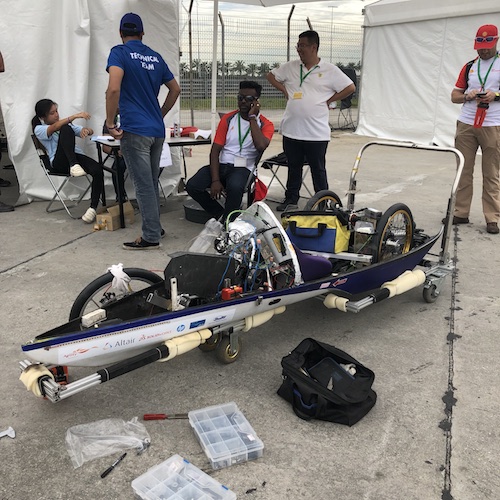
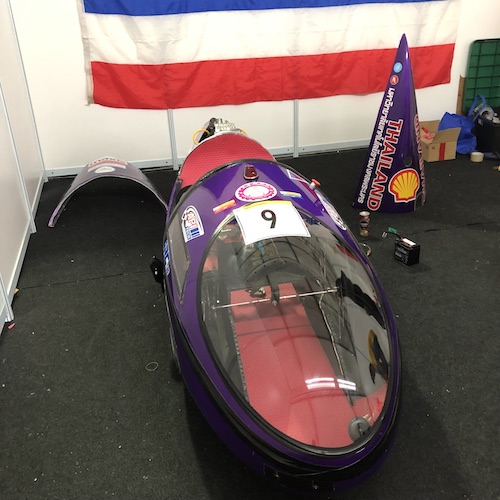
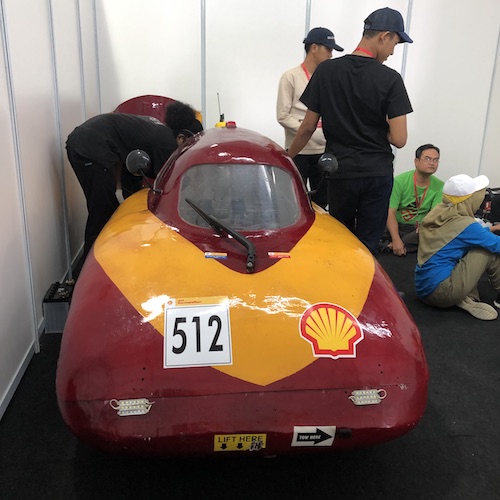
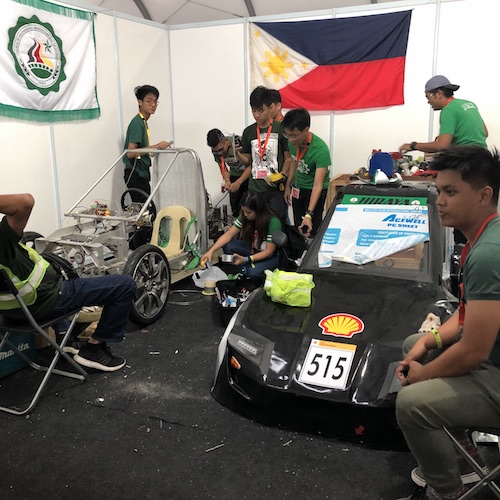

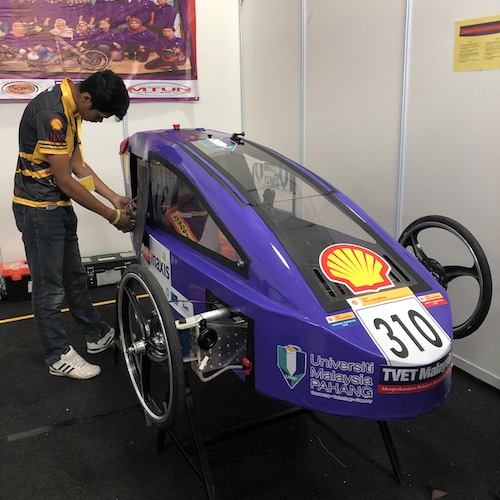

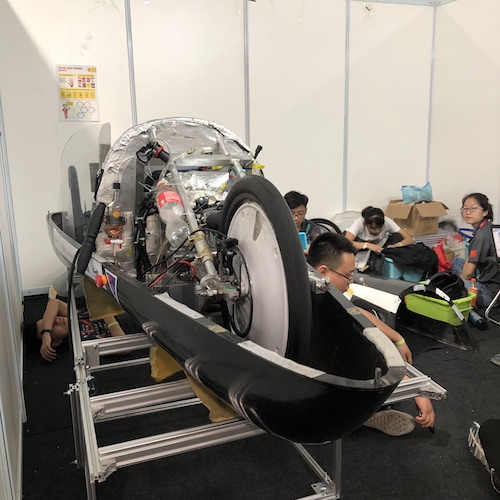

- Published: Monday, 13 May 2019
It's been full-on in Malaysia at Shell Eco-Marathon Asia. The most exciting thing has been tracking our Australian entrant, Girton Grammar Team Incharge, as they navigate their way through the competition.
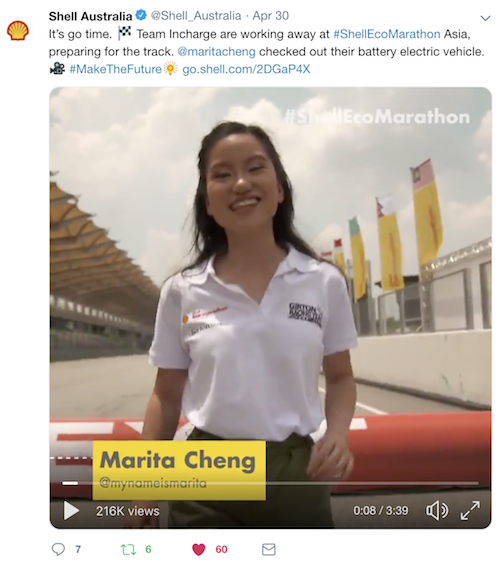
(click here or on the image above for a video summary of Day 1)
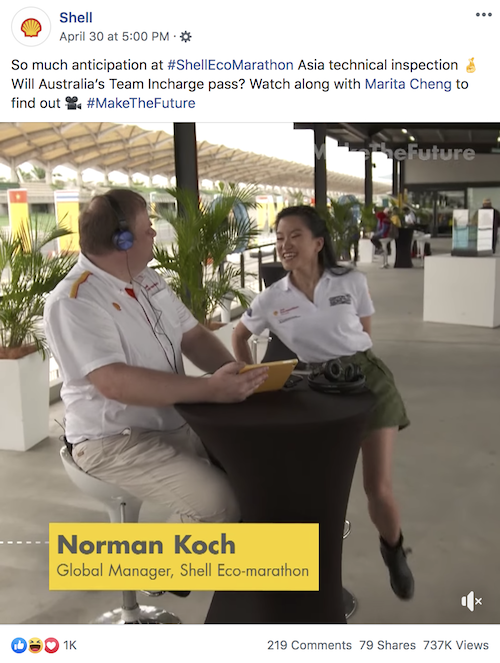
(click here or on the image above for a video summary of Day 2)
Our Aussie team began their journey auspiciously, making it through immigration at Melbourne Airport 20 minutes before the immigration computer system shut down, causing massive queues and chaos for everyone else trying to travel!
They nearly didn’t make it through though − one of the students, James, had never travelled internationally before, so he didn’t know he was meant to look up to the camera after getting his passport scanned, which the rest of the team found hilarious!
The team arrived in Kuala Lumpur late on Sunday night, 28 April, the day before the competition began, and arrived at the hotel at 1am on Monday 29 April, the day of competition.
Running on adrenaline, the team got to work early, assembling the car and putting in the electronics. The tests were running well, and everyone was relaxed and confident, until suddenly, the wheels of their car stopped turning! The next couple of hours were slightly frantic, with the students running around trying to diagnose the issue. After filming our Day 1 video with the team, they figured out the issue: some wires had become loose and the emergency stop button’s terminals weren’t connected properly - so there was no power going into any of the circuits.
Our Australian team was one of the select few fortunate to be invited to parade their car at the opening ceremony. It was great to see them walk proudly with their car in front of 18 countries and 108 teams, representing Australia under the scorching Malaysian sun.
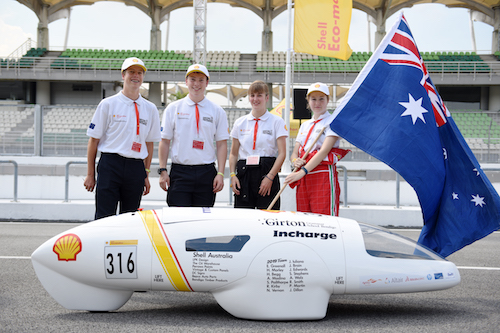
Tuesday brought the technical inspections. The team was confident going in, but the technical inspectors were tough and weren’t letting them off easily.
The technical director was concerned about whether the Girton team’s drivers had enough experience in the vehicle. The Incharge drivers had a lot of experience in other similar vehicles, and have raced in other competitions, but the technical director wanted to further assess their driving ability before letting them compete.
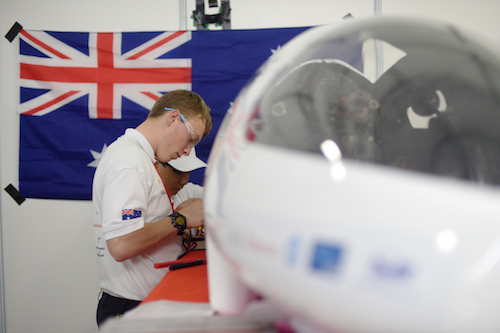
An interesting test was to see if the drivers could jump out of the car in less than 10 seconds, in case there was a fire. Incharge drivers managed 9.36 and 8.72 seconds, just under the threshold. Phew!
All up, the team spent over 3.5 hours in tech inspections, tying up cables and affixing them out of the way to ensure the car was as safe as possible.
Finally, Team Incharge passed technical inspection, allowing them to drive on the iconic Sepang International Circuit!
Even though the car was now certified track-legal, the technical director still wanted to make sure the team knew how to drive. So the Girton drivers had to do two laps of the track successfully to show the director they could handle the track and car.
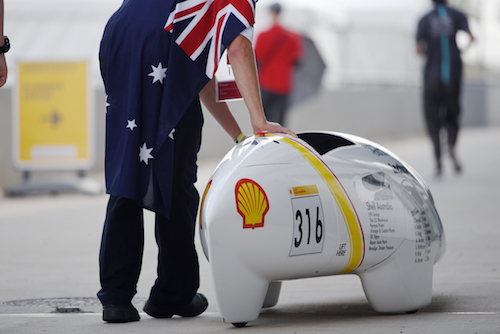
Incharge driver Emma got in the car to show her stuff. We watched as the beautiful Girton vehicle glided along the track. But then the display screen shut off and Emma was forced to drive the vehicle off the track. She didn’t even complete one lap − something had gone wrong!
Turns out the display board wire came out and Emma couldn’t see any updates, so she decided to stop to check it out, to make sure everything was functioning properly.
With the display wire securely plugged in, Emma tried again, successfully doing two laps of the track to show the technical director that the team was ready to compete.
Each car goes around the track four times to make a run. Each team is given eight attempts to lodge their best distance travelled per energy unit. The winner is the team with the most energy-efficient car in the division.
Girton Grammar Team Incharge had their first run that Tuesday afternoon. Four laps of the track, using the least amount of energy they could.
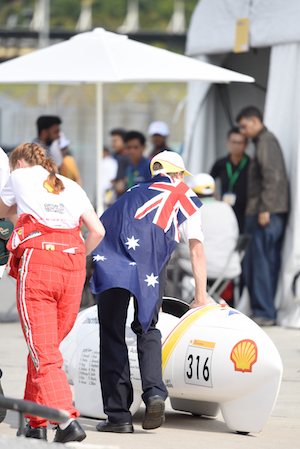
Incharge went around once, twice, three times. Up the hill, down the hill. The finish line was in sight. Just one more bend…and then…nothing. With the finish line in sight, Girton’s vehicle stopped on the home stretch. Oh no!
So that’s one attempt down but nothing on the scoreboard yet. Only eight out of the 22 teams in their division managed to complete their first run attempt.
With two days of competition to go, let’s see how Girton manages to fight back and prove their mettle!
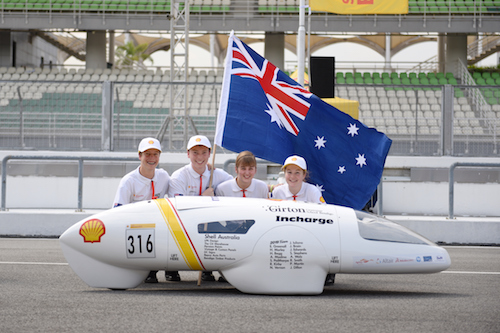
- Published: Tuesday, 30 April 2019
Ask yourself:
1. What do I want to learn?
2. What do I already know?
Then:
3. Devise a project you’re interested in that involves others
- Create a community
- Have a clear common aim
- Work towards external deadlines
1. What do I want to learn?
Figure out what you want to learn or the challenge or goal you want to conquer.
When I was in my second year at university, I had never built a robot from scratch before. I’d done soldering, built electronic crickets from kits, soldered together a multimeter, put together various toy cars, and built a whole bunch of stuff with LEGO robots − but I’d never built my own robot from scratch! So I decided that I was going to build a simple robot to roll around the room by itself with my friends. We called the team “mew”, after our names.
2. What do I already know?
Learning something new is hard. So you want to make sure there aren’t too many obstacles between you and success. It’s good to be aware of your strengths and weaknesses so you can ask for help when you need it and ensure the project’s success.
My friends and I didn’t know much about building robots, so we breadboarded some motors and LEDs, but we didn’t achieve our objective. I then got busy building Robogals and studying in London. I next decided to build a word clock, which tells the time using words rather than digits. There weren’t as many tutorials on word clocks back then, so I asked my housemate Luke, an enthusiastic electronics hacker, to help guide me through the process. I bought a whole bunch of components from the electronics markets to make my own circuit boards.
3. Devise a project you’re interested in that involves others
− Create a community
Doing things by yourself is lonely. Getting other people on board creates energy around the project and makes it more exciting. It’s nice to bounce ideas off other people, brainstorm and refine ideas to come to the optimal solution, while making friends. To ensure your project gets completed, create a community around it. That might be just one person, your best friend who is curious or the local hacking community you find at Hackerspace.
I didn’t have much time to work on my word clock, before getting busy with university. Thankfully, we finally started doing some hands-on robot building in my mechatronics engineering and computer science course. We were going to compete in the Warman Challenge, where you build two devices − one completely mechanical, and one electro-mechanical − to complete a task. It was a group project, so I worked with a few classmates, and we finished the university assignment!
− Have a clear common aim
Be clear about what you want to achieve. Talk to as many people as possible about your idea. Refine it as much as possible. Then agree on the scope of the project with your team.
A month later, my friend forwarded me an email about ABC’s New Inventors, a tv show that showcases Australian inventions and innovations. The producers were filming a “Robot Special” episode. They were looking for sumo robots to compete against different universities around Australia. I quickly emailed back, putting my hand up to enter a team with Luke.
− Work towards external deadlines
By having an external deadline, the project gets done. This way, it’s not just the team holding you to account to complete the project, but other people in the wider community as well. This causes you to step up and deliver.
Less than two months later, I was a panellist on the ABC’s New Inventors and our robot competed and tied for third place. If we didn’t have the hard deadline of the filming date, we wouldn’t have completed our sumo robot.
With the hardware skills gained from working on these projects, I had the confidence to build more robots and then start my own robotics company, aubot, making telepresence robots for people to go to school or work remotely.
Competitions like Shell Eco-Marathon enable you to learn valuable hands-on skills, create a community for you to work with towards a clear common aim and give you an external deadline so the project gets completed. When people ask me how they can learn these kinds of valuable skills − technical, project management, teamwork, leadership, etc − I tell them to look for competitions like Shell Eco-Marathon.
- Published: Monday, 29 April 2019
I’m very excited to announce that I have been named the 2019 Shell Eco-Marathon Ambassador for Australia.
The concept of the Shell Eco-Marathon stems from a friendly bet between two scientists at Shell in 1939. How far could a vehicle travel on a gallon of fuel?
They shook on the bet and set about stretching the limits. By 1985, Shell Eco-marathon became a student competition. Now, 52 countries, more than 700 teams and 6000 students are participating in the Shell Eco-marathon across Europe, North America and Asia Pacific.
I like the competition because it’s not about building a fast car − it’s focused on minimising the car’s environmental impact.
A great way to learn is to create a project and work with other people to achieve a common aim under the pressure of a deadline. The other people help keep you motivated so that you feel a sense of responsibility beyond yourself. The common aim directs what you’re working towards. And the deadline pressure means that the project has to move along at a snappy pace to be completed. Shell Eco-Marathon ticks these boxes: the project is to create the car; you’re working in a team; the aim is to create an efficient, eco-friendly vehicle; and the deadline is the competition dates.
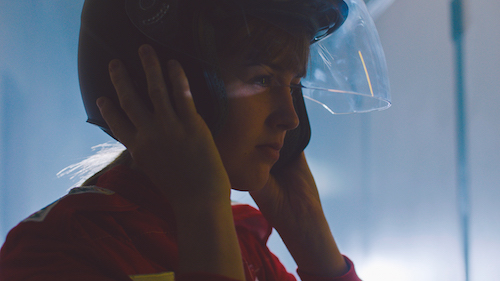
You can learn so much through participating in a competition like this: coming up with the requirements, brainstorming designs, and building a car and the electronics. It’s not just applying the science theories you learn in the classroom. It’s building something with your hands, problem solving, working in a team, and knowing yourself as someone who can make things happen. These are the same skills we use every day in my robotics company, aubot, where we make robots for people to go to school and work remotely! Competitions like Shell Eco-Marathon set you up for the real world, giving you the technical skills and confidence to make stuff happen.
The competition is open to secondary school and university students.
A secondary school in the regional Victorian town of Bendigo, Girton Grammar School, heard about the competition and decided to enter.
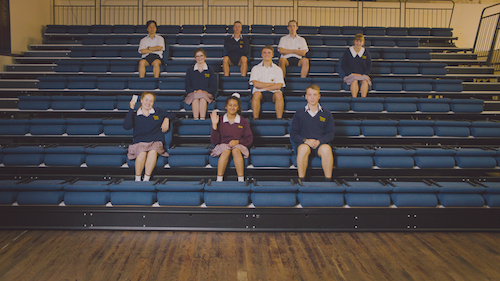
The young team worked hard and built an electric car, managing an impressive 6th place finish in their Mileage Challenge category!
Encouraged by their experience, Girton’s Team Incharge has once again put their hand up to participate in Shell Eco-Marathon as the sole team representing Australia in this year’s Asia Pacific finals in Malaysia. This year, Shell Eco-Marathon Asia has 100 student teams representing 18 countries!
A month ago, the Girton Grammar team packed their car in Bendigo and sent it to Malaysia. Today, Shell Eco-Marathon Asia began.
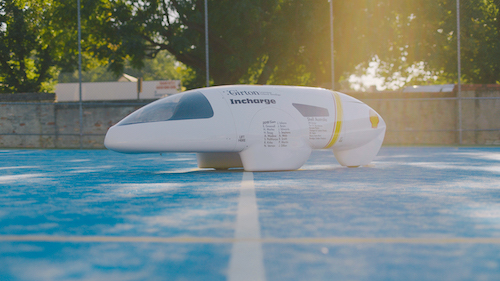
Girton Grammar has two days for tech checks and to make any final changes to their car, including electronics integration and testing. Then it’s competition time!
Over the next two days, the Girton Grammar students will get to compete and test their hard work against hundreds of other students in the region.
As the Shell Eco-Marathon Ambassador for Australia, I was invited to go along to Malaysia with the Girton Grammar team to report on their progress, as well as find out about and report on the other teams and what they’ve brought to the table.
I can't wait to be part of the action and give you more updates about Shell Eco-Marathon Asia throughout the week! Go Australia! Go Girton team Incharge!
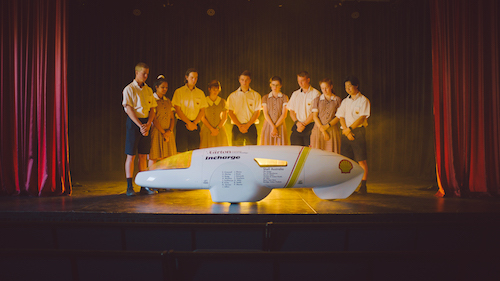
- Published: Tuesday, 12 March 2019
About Me
 Forbes named me a world's top 50 woman in tech & 30 Under 30. I founded Robogals and Aipoly and was Young Australian of the Year 2012. Currently working on robotics company Aubot. I'm the youngest Member of the Order of Australia (AM) and I give speeches around the world.
Forbes named me a world's top 50 woman in tech & 30 Under 30. I founded Robogals and Aipoly and was Young Australian of the Year 2012. Currently working on robotics company Aubot. I'm the youngest Member of the Order of Australia (AM) and I give speeches around the world.
I tweet @maritacheng and I'm on Facebook.
Subscribe
Random Articles
-
How to choose your projects
Ask yourself: 1. What do I want to learn? 2. What do I already know? Then: 3. Devise a project you’re interested in that involves others - Create a...
-
Austrade San Francisco Landing Pad
In late 2018, Aubot participated in the Australian Trade and Investment Commission’s (Austrade’s), Landing Pad program, which helps successful...
-
Pebble Beach Authors & Ideas Festival
I was invited to speak at the Pebble Beach Authors & Ideas Festival (PBAIF) in Pebble Beach. What a stunning part of the world! Most other speakers...
-
Asia Game Changer West
Growing up, I read stories about technology being created in San Francisco. So I was truly honoured when I was named an inaugural Asia Society...
-
Regaining focus
During my time at Robogals, towards the end of every year, I would lose focus. Why? All my major projects for the year would have been wound up. My...
-
Greater than 0.00%
No matter what choices you make every single day, life is unpredictable - everything is unpredictable. So all you can do is prepare the best you can...
-
American Australian Association: Next Generation Leadership Award
I received an award in New York City from the American Australian Association: the Next Generation Leadership Award. As a result, they're planting a...
-
The worst that can happen
When I was growing up, my mum earned about $20,000 a year to support herself, my brother and I. By living very frugally and only spending money on...
-
Accolades: Sonya and Harry
I'm so proud of Sonya Chan and Harry Eakins, who were both recognised by their faculty at Imperial College for Services to the Community. Sonya Chan...
-
Dianne's Garage
This is how I spend the majority of my time: Hanging out with my mentor Dianne in her awesome workshop.



